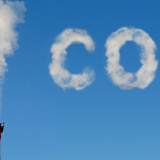A sophisticated analysis of the global climate crisis is accelerating as quickly as it is approaching. But a gulf is widening between our understanding of this most serious of modern environmental concerns and our efforts to fix it. The latest example could be called the carbon dilemma.
The carbon dilemma first received public attention in 2012 when Bill McKibben, an American environmentalist and founder of 350.org, publicized the growing conflict between the known carbon that is stored in fossil fuel reserves — the equivalent of 2,795 gigatonnes of carbon dioxide — and the amount we can afford to burn, the equivalent of 565 gigatonnes of carbon dioxide. If the traumatizing effects of increased global temperatures are to be avoided, this means that 80 percent of these carbon reserves — presently valued at about $20 trillion — must remain unused in the ground.
Meanwhile, investment in fossil fuels continues unabated, as if the industry and its financial supporters are oblivious of this dilemma. Australia has spent $6.2 billion in developing new coal reserves in Queensland, a “mega-mine” that some critics have deemed the world’s second largest “carbon bomb”. Even though many coal companies and their backers profess to be taking global climate change seriously, they are still funding projects that, given the emerging calculations, seem risky at best and suicidal at worst.
The same might be said of Alberta’s tar sands, an investment adventure that now involves $120 billion and counting. Saskatchewan and Manitoba, where they share the Bakken deposits of North Dakota, are joining the rush for shale oil. British Columbia is frantically fracking for natural gas, while desperately looking for investors who will build the LNG facilities that are supposed to fuel the province’s future prosperity. The United States is similarly fracking to establish energy independence. In 2012, the world’s top 200 energy corporations spent $674 billion finding new fossil fuel reserves, an investment strategy that hardly seems compatible with any intention to reduce consumption.
As the carbon dilemma comes into sharper focus, it reveals a stark and disturbing contradiction in the energy strategy promoted by fossil fuel corporations — one even hugely subsidized by governments. Atmospheric carbon dioxide levels have increased 40 percent since 1750. The amount of radiant heat escaping from Earth has fallen by 30 percent between 1990 and 2011. This unequivocal scientific evidence should mean that burning large quantities of fossil fuels has a very limited future — even if we have access to such energy. But investment continues as if all that can be found can be burned. A haunting doubt must question the sanity of searching for more carbon than we can afford to release.
Efforts compatible with free-market principles have been made to reduce carbon emissions, the most obvious being the European carbon trading scheme. But it has failed because carbon quotas were initially set too high, because too many sellers and too few buyers have collapsed the value of carbon, and because the European parliament has refused to bail out the faltering scheme. The only realistic remaining option is a direct tax on carbon, a regulatory step that free market capitalism is reluctant to implement, that national governments are too cowardly to enact, and that competing global interests find too complicated to organize into binding agreements. (One of the few exceptions is British Columbia, where a careful academic study has shown that the implementation of a carbon tax in 2008 has lowered the province’s greenhouse gas emissions by 17.4 percent in the four years to 2012 without impairing economic growth, a reduction that compares to a 1.5 percent increase in emissions for the rest of Canada.)
So the carbon dilemma culminates in the realization that the 200 largest fossil fuel corporations in the world, worth an estimated $4 trillion in stock market value — they also have $1.5 trillion in debt — can only burn all their reserves if they intend to heat the planet to a devastating 6°C (Will Hutton, Guardian Weekly, Apr. 26/13). Without a miraculous means of capturing and safely sequestering all carbon dioxide emissions, this suggests two options: we can attempt to adapt to conditions that will likely be suicidally severe, or the fossil fuel corporations must acknowledge that most of their assets are unusable and worthless.
If this second option reaches a critical mass of awareness in the marketplace — as it eventually will — the world’s economic system will have to bear the shock of another financial crisis as trillions of dollars in investments disappear, and the cumulative impact of related disturbances send seismic shocks throughout the entire market place. Fossil fuel, in other words, is a carbon bubble that must eventually burst. The alternative to shocking the market is to spend trillions of dollars attempting to live with the consequences of a planet that is 6°C warmer, a hydrological cycle that will be 42 percent more active, and other surprises that we probably don’t want to imagine.
The stakes are unimaginably high. Our wealth, our value systems, our material security, our political stability, and just about everything we recognize about our modern civilization will be determined by the key energy decisions we make in the next few years.
The way this dilemma resolves itself will be unpredictable given the economic leverage and the lobbying influence of the oil, gas and coal corporations, not to mention the importance of fossil fuel as the primary energy source still powering the global economy. Willing or not, every single person in the world will become a player in this environmental drama. How it will end is uncertain.

